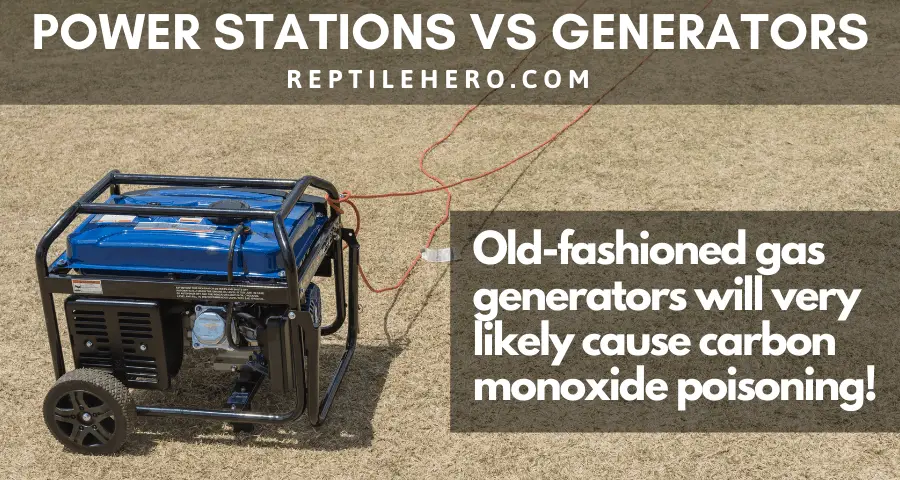How To Choose A Power Bank For Your Leopard Gecko [Size, Type]
A power bank can make a difference in ensuring a leopard gecko’s safety in case of a serious power cut. In 1997, a large colony of captive-bred leopard geckos was left with no choice but to weather through 32°F (0°C) for up to 2 days. This is because the breeder had no backup power source during an extreme thunderstorm. Sadly, most of them died during and after the incident– avoid this from happening with a reliable power bank!
The average leopard gecko keeper must take 6 factors into consideration when choosing a portable power station for their pet’s well-being in times of crisis:
- Total battery capacity
- Type and number of ports
- Way and time for a full recharge
- Weight and dimensions
- Overall product design
- Additional features
Before checking out that power bank you have in your virtual shopping cart, find out if it actually suits your and your precious leopard gecko’s needs!
If you are in a hurry check our article on the best power bank for gecko tanks.
6 Factors to Consider When Choosing a Portable Battery-Powered Outlet
Portable power stations (also alternatively called portable battery-powered outlets or power banks) are similar to the small power bank units most people use to charge up their smartphones on the go – but on steroids.
Unlike the small and light power banks most people are more familiar with, portable power stations are capable of providing a convenient alternative power source not only for small electronic devices, such as tablets and laptops, but also light fixtures, heat sources, and home appliances.
Do All Gecko Keepers Need a Portable Battery-Powered Outlet?
In normal circumstances with an available electricity supply, portable battery-powered outlets are not necessary. However, in the case of day-long power outages which cause enclosure ambient temperatures to drop below 65°F (18°C) or rise above 90°F (32°C), an external source of electricity as the one provided by a portable battery-powered outlet is necessary.
Conversely, professional breeders and expert keepers who are operating completely off-grid or already have a backup power system in place do not need to purchase an additional compact power station unit.
When choosing a portable power bank for a leopard gecko it is important to consider the following aspects:
- Battery capacity
- Available ports
- Recharge methods
- Weight and dimensions
- Product design
- Bonus features

Continue reading to learn why these factors are important.
#1 – Battery Capacity and How to Measure It For a Gecko
The first and foremost factor you should consider before buying a power bank for your leopard gecko is the total amount of electrical energy the unit can store in its battery and provide for you once fully charged.
You can easily ascertain a portable power station’s total battery capacity by determining its Watthour (Wh) – electrical energy it can supply for a period of time [1]. This information is usually readily stated in the product’s name, on the unit itself, and its manual or user guide.
Just to make you familiar with the concept, 1000Wh will allow a device of 1000W of power (check the label) to stay ON for 1 hour. Also, the same 1000Wh will allow a device of 500W of power to stay ON for 2 hours. In other words, the time a device can stay ON when supplied by a battery is simply given by Battery Energy divided Device Power.
After a quick check on online shops, you will see portable battery-powered outlets with a variety of capacities. You will find units rated at 240 Wh, 300 Wh, 520 Wh, 1000 Wh, 2000 Wh, and what have you. Of course, the larger the energy it can deliver, the larger volume it will use (as the energy is “stored” in chemicals inside the battery).
Personally, I think portable power stations that offer a total battery capacity that is in the 500 Wh range are great options for pet parents who look after a single leopard gecko.
Of course, if you have a large family of leopard geckos housed in individual enclosures or an adult leo that is housed in a massive bioactive tank, you will likely need power banks with higher battery capacities or a couple of mid-tier units. Gecko-keeping is highly specific to each enthusiast so always enter your specific needs into the equation.
5 Easy Steps to Find the Battery Capacity For Your Gecko
To find the size of a portable battery to supply all the devices in a gecko tank it is important to
- Make a list of all essential devices and fixtures
- Record their corresponding rated wattage
- Tally the rated wattage of essential elements
- Multiply the sum with your expected time of usage
- Choose a unit that matches or goes higher than your estimate
Below is a series of more detailed instructions on how to calculate your gecko’s battery capacity needs.
Step #1 – Make a List
Enumerate all of the things you would need to keep your leopard gecko safe in its enclosure in case of a power outage. Typically, such a list will include lighting and heating elements that usually run on electricity. For a summer blackout, you may instead need a fan like this one on Amazon.
If temperatures regularly fluctuate throughout the year in your area, make a separate list for each season. You should also create different lists for daytime and nighttime because you would only need heating or cooling devices at night.

Step #2 – Record the Watts.
Once you have made a list, check the wattage rating of your light and heat fixtures. Watt (W) or kilowatt (kW, this is 1000 Watts) indicates the amount of electrical power a device needs in order to function properly.
You can find this information on any electric device (as this is required by law). It is usually on a white sticker at the bottom of the device (not readily visible).
Step #3 – Add It All Up
Then, simply sum up the power (Watts) of each device in the list. For example, a 20-gallon long tank will be okay with a small 8 W ultraviolet-B (UV-B) lamp and a 16 W heating mat during daytime tallies up to 24 W.
Step #4 – Consider Usage Time
If you are only taking a whole day (24 hours) of power outage into account, multiply your day and night lists with their respective hours of operation.
Using the same starter set-up example from before, 24 W for light and heat to operate for 12 hours would be 288 Wh for the day. Subsequently, 16 W for heat to operate for 12 hours would be 192 Wh. Hence, you will consume 480 Wh of electrical energy for one day.
Step #5 – Match Up Your estimates
Now that you know how much electrical energy you need, look for a portable power station that meets that minimum requirement. It is important to note that in such instances of emergency (e.g. blackout), it will always be better to have an alternative source that is more than enough for your precious leopard gecko’s needs. So if 480 Wh is your minimum, opt for a 500 Wh power bank instead.
Can You Run a Portable Power Bank Continuously for 24 Hours?
You can run a portable power bank for 24 hours straight or more. That is, of course, provided that your electrical energy consumption will allow for your portable battery-powered outlets’ battery capacity to last that long.
If you’re planning on maxing out your unit’s battery capacity right from the start, then don’t expect it to last any longer than one hour.
#2 – Type and Number of Ports
Most electrical devices and fixtures used in updated leopard gecko husbandry practices ordinarily have Type A or B plugs that need to be connected to an AC wall outlet in order to work. As such, it is important to check a portable power station’s port types and how many there are of each.
Generally, there are two main types of ports: 1) alternating current (AC) port and 2) direct current port.
Without going into too much details, you need to know that an AC port provides the same type of electricity that your house sockets provide. On the other hand, a DC port provides that type of electricity that a small electronic device needs (for instance the USB ports in your computer are DC ports). Usually, AC sockets provide an electric current with higher voltage (120V in the USA and 220/230 in EU – the voltage as well can be found in the label) while DC plugs provide low voltage currents (like 12V).
| Regular Device | Current Type (DC or AC) |
| Heat mat | AC |
| Ceramic heat emitter (CHE) | AC |
| Deep heat projector (DHP) | AC |
| Halogen lamp | AC |
| Ultraviolet-B (UV-B) light | AC |
| Full-spectrum light bar | AC |
AC ports usually look like the normal or universal sockets we have at home or in the office in the office. DC ports, on the other hand, may appear as male or female jacks, car ports (more commonly known as cigar lighter ports), Universal Serial Bus (USB) ports, as well as Anderson ports. The last port is commonly used to connect solar panels to a unit.
When it comes to the aspect of ports in a power bank, I go by the popular saying “the more, the merrier.” Sure, it might seem like a bit of an overkill at first. But having a handful of different ports could actually be more convenient for you in the long run – especially if you are planning to adopt, rescue, or buy another gecko sometime in the future.
Plus, let’s be totally honest here. If there is a power outage, your leopard gecko won’t be the only one in need of an alternative source of power. If you’re all out of options when it comes to information and communication, you may also have to charge your phone and plug in your modem/router for a few minutes.
#3 – Way and Time for a Full Recharge
Different brands and different models may provide different ways of recharging a portable power station unit. Each company, store, and/or reseller may also offer packages and accessories at discounted rates.
Currently, most mid-tier portable battery-powered outlets available in the market can be recharged in 5 ways:
- From a regular AC wall outlet
- Using solar panels (here on Amazon) – is very important if you live off-grid
- Through a car lighter port
- With an old-fashioned fuel-fed generator
- By means of a lead-acid battery
In terms of recharging methods for power banks, leopard gecko keepers would need to have various options they can rely on other than a wall outlet. Recharging via a wall outlet during a blackout or a solar panel during a typhoon or snowstorm would not be possible. Moreover, not every keeper owns a car or can use a gas generator. So if possible, find a unit that offers at least three of the aforementioned methods for recharging your leopard gecko’s power bank.
Generally, fully recharging a portable power station will only take a few hours (8 hours on average) regardless of the recharging method used. Do keep in mind, however, that various factors may affect how long it will take to charge a battery power bank in specific situations.
For example, relying on solar panels to recharge your power station may take longer than usual on a moderately cloudy day. Meanwhile, portable battery-powered outlets that allow for dual recharging (i.e., using two input ports at the same time to replenish battery capacity) can speed up the process and decrease the total time spent for recharging. However, some clever tricks will enable you to fast-charge portable power stations using solar panels. So if you’re knowledgeable when it comes to electronics and the like, watch this.
Can You Use a Battery Power Stations While It’s Being Recharged?
Battery power stations can be used while being recharged. More technically, this is called pass-through charging. Some support simultaneous charging and discharging via both AC and DC ports. Other units can only sustain pass-through charging through one port type, Ac or DC.
Bear in mind though, it is not advisable to do this habitually for prolonged periods. As a matter of fact, most companies will still warn against possible battery damage and degradation as a result of such practice despite stating that their products are made to support it. My advice is to only do pass-through charging when you are out of other options.
#4 – Weight and Dimensions
In cases of natural and man-made disasters where you would need to be ready to travel with your leopard gecko at a moment’s notice, having a high-capacity portable power station that is both compact and lightweight enough to carry by hand is crucial.
The battery capacity and size (weight and dimensions) of a portable battery power station are usually directly proportional. As a unit’s capacity increases, so do its weight and dimensions.
To paint the picture for you, 200+ Wh power stations weigh in at about 6 lbs (3 kg), 500+ Wh power stations are usually around 15 lbs (7 kg), and 1000+ Wh power stations are roughly 24 lbs (11 kg). Starting from a 1000 Wh capacity, higher-powered units are still technically portable – with wheels and handles – but not necessarily easy to carry.
But it’s not like you will have to constantly carry a unit while providing light and heat to your leopard gecko. So balance your needs for alternative electrical energy with transportability.
We wrote a fully guide on the best power bank if you are in a hurry.
While doing your own supplemental research on different units available not only online but at your local electronic and hardware stores, you may notice that smaller mid-tier and top-tier units usually rack up higher prices. Even between brands, power stations of the same battery capacity will be much more expensive than heavier models.
However, since the demand for such power alternatives has only recently diversified as a result of more frequent planned and unplanned power interruptions, you can expect more high-powered battery power stations packed in smaller units available at more affordable prices in the future.
#5 – The 4 Design Features to Look At
Okay, I know that the overall product design might seem incredibly superficial to some of you that you’re thinking it shouldn’t be included in this list. But just hold on, I have my reasons for this taking this into consideration as well.
A portable battery power station’s overall design may affect not only portability but user experience as a whole and storage as well. The design features that must be considered when choosing a power bank are 1) handle, 2) shape, 3) display, and 4) port cover.
Handle
A portable power station’s handle(s) are usually either permanently fixed into place or made to swing and fold back seamlessly into the unit’s body. Fixed handles provide better stability during handling but foldable handles offer more ease in storage.
The handle itself may also be curved or flat-and-angled – the former style is more ergonomic. By contrast angled handles may be uncomfortable after prolonged handling as the edges may feel as though they are cutting into your palms, however, rubber grips may prevent this.
Shape
Similar to the handles, a portable battery-powered outlet’s shape could affect the user’s comfort when it comes to carrying the unit around, especially higher-capacity ones that are heavier.
Look for power banks with smooth or curved edges so carrying it by your side with one hand or in front of you with both hands will be a much more pleasant experience. You won’t have to deal with sharp edges painfully digging into your thighs.
Display
Older models usually have 25%, 50%, 75%, and 100% simply printed out on the casing of the portable power bank with tiny indicator lights for each one. If that won’t pose any problems for you, you can go for such models.
However, units nowadays are equipped with LED or LCD display screens that provide more accurate input and output data among many other important pieces of information. These could have a separate switch for the display screen light. Some are even touch-screen!
Do You Need to Program a Power Bank Before Using It?
You normally do not need to program a power bank before using it.
If you have ever used one of those pocket-sized power banks for phones and tablets like this one on Amazon, you won’t have any trouble using bigger battery power stations similar to the ones I have already mentioned.
However, I have come across and read about newer models that would require manual activation for additional built-in features.
Port Cover
Unlike smaller power banks made for recharging electronic gadgets on the go nowadays, most high-capacity battery power stations do not have port covers. This provides extra protection against dust and moisture that may cause degradation of your ports and render them unusable or unsafe to use.
So when you do get to the point of having to choose between incredibly similar models, I recommend that you go for the unit that has port covers built into the body itself.
Are Portable Power Stations Waterproof?
Most mid-tier and top-tier portable battery-powered stations are not waterproof, much like any other high-capacity power units and electrical devices.
Although some models are made of water-resistant materials, at the present time, it’s impossible to have a battery power station that is 100% waterproof because it needs to have vents to let out hot air produced while being used. If water gets in through the vents or ports, the electrical parts inside will surely be damaged.
On the brighter side of things – if are only inquiring about water-proofing for safer transportation and storage, there is a solution. Just buy a padded water-proof carrying-and-storing case for your portable battery-powered outlet.
#6 – Premium Features
To reiterate, different brands offer a distinct set of built-in additional features for the individual portable power stations they sell. These aspects are basically the cherry on top of their products.
However, these extra features may also come at a premium which is why more expensive models usually showcase a lot more uncommon features. You need to be wise in considering the practicality of such things for your situation.
Here are some additional features leopard gecko keepers should take note of.
Battery Protection
Portable power stations with a battery management system (BMS) is preferable because it makes up for common user error done when the unit is used. Such a system normally includes functions that prevent short-circuiting, improve battery utilization, and provide surge protection.
Others simply automatically shut down after a few minutes of getting turned off power-saving mode. This allows you to avoid inadvertently draining your units when you forget to turn them off.
Each brand sells a portable power bank model that activates the power saving mode once it continuously discharges fairly low electrical power to a device that’s still plugged in after a certain number of hours.
Cooling System
Portable power stations can heat up when they are in use. This is not necessarily a cause for concern though. High-capacity mid and top-tier battery power banks usually have built-in cooling systems that automatically turn on once the unit reaches a certain level of internal temperature while in use.
A unit’s cooling fan will usually be switched on around the 86-113°F (30-45°C) range, and then the air vents also allow for hot air to escape the body. This feature is highly beneficial as overheating is one of the major causes of lithium-ion battery degradation [2].
In short, you won’t have to worry about your unit overheating and going up in flames like old-fashioned generators. Just make sure to never block off the vents while the unit is operating.
Error Recording
A few battery power banks now have an error recording (also referred to as fault history taking) function. This keeps a detailed log of problems and issues encountered during the use of the unit – be it due to the machine itself or the user.
It is incredibly helpful especially when you are asking for troubleshooting and technical support. Even when the codes are not readily understandable, having them will help the company representative find a relevant solution for your problems. Then in the future, you will know what you should or should not do.
This feature is still a fairly rare find among the majority of portable battery-powered outlets currently up for sale in local and online electronic-hardware stores. However, I think this should be built into all future models.
Wireless Charging
Due to the increasing popularity of wireless charging, the production of portable power stations with wireless charging stations on the units’ bodies is becoming more commonplace. This is a great additional feature you should check for while you’re window-shopping for your leopard gecko’s dedicated power bank.
Even though your cold-bellied baby’s need should take top priority here, remember that mediums for information and communication are extremely vital in times of emergencies. So being able to charge your phone while providing adequate lighting and heating for your leopard gecko is definitely a great bonus.
ANDREA TO ADD LINK TO COMMERCIAL
Emergency Light
Having a light source built into the body of your portable battery-powered outlet may seem pretty random, but it will surely come in handy. You can use it as a night light or a simple “save our souls” or SOS signal light when you need one.
If you are not familiar, a visual distress or SOS signal is done with a succession of three short, three long, and three short flashes of light. Keep this in mind so that you will know what to do when you find your leopard geckos, yourself, and other pets in a situation that would require rescue and/or evacuation.
Why Not Buy a Gas-Powered Generator Instead?

After reading all of that so far, a few of you might still be thinking “why not just use a good old-fashioned generator that can run on fossil fuels like kerosene, propane, and diesel?”
Well, if a keeper owns a house of their own, purchasing a relatively affordable, branded, high-quality, and high-capacity engine generator will make a lot of sense.
However, for the countless other keepers living in a condo, apartment, or renting out a room, buying a gas-powered generator comes with a couple of big issues that the cheap price just can’t make up for.
Despite the fact that engine-powered generators are available at cheaper prices for higher power capacities, it comes with numerous disadvantages:
- Bulky and heavy
- Very noisy while in operation
- Cannot be used indoors
- Needs regular maintenance
- You must have a steady fuel supply
- Highly flammable
- Could cause carbon monoxide poisoning [3]
For these reasons, I would most likely continue endorsing a battery power station instead of a gas generator to other leopard gecko keepers, and many other pet parents, looking for alternative power sources to purchase.
How About Battery-Powered Reptile Heat Source?
For now, I feel like the use of battery-powered heating sources specifically marketed for reptiles like leopard geckos is not advisable.
The main reason for this being that such products that were sold as such do not have built-in temperature regulating systems – similar to a regular thermostat. As such, the safety of such products has yet to be given evidence.
Of course, if tried-and-tested, completely safe, battery-powered heating elements for reptiles are to be easily available in the future, I would be all for trying them out with a reasonable level of precaution.
Lastly, if you have any other questions I have not addressed yet, kindly drop the Reptile Hero team a message here.
Takeaways
A good portable power station for your leopard gecko should have 1) ample total battery capacity, 2) many different types of ports, 3) multiple methods to fully recharge the unit in a couple of hours, 4) sturdy but compact build for portability, 5) ergonomic overall product design, and 6) offer sensible additional features.
Gas-powered generators are also great products to consider however it is not a viable alternative source of power for a great number of leopard gecko keepers. Furthermore, portable battery-powered outlets are much safer to use both indoors and outdoors.
Sources
[1] https://www.eia.gov/energyexplained/electricity/measuring-electricity.php


![Are Geckos Sensitive To Sound? [4 Reasons, 9 Signs, 7 Tips]](https://www.reptilehero.com/wp-content/uploads/2021/03/G41-768x614.jpg)



![9 Woods Safe For Gecko Tanks [and 16 to Avoid]](https://www.reptilehero.com/wp-content/uploads/2021/04/Wood-Avoid-Gecko-Tank-768x614.jpg)
